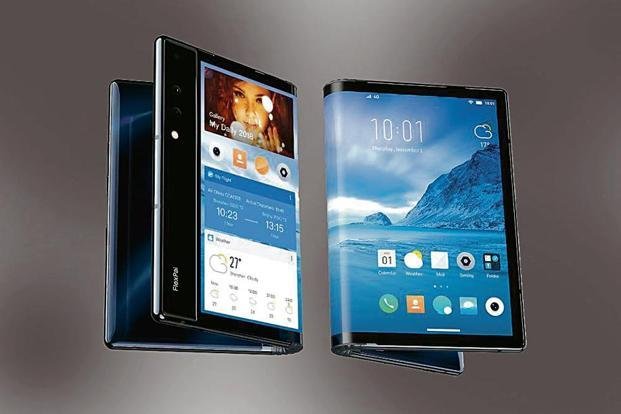Technology
The future of smartphones is just unfolding
With foldable screens, makers can accommodate bigger screens in a form factor that would fit into a pocket
New Delhi: Smartphones have evolved a lot since Steve Jobs first introduced the Apple iPhone with a multitouch display in 2007. Screens are much bigger now with the latest iPhone sporting a 6.5-inch screen, which allows people to use their smartphones for work and entertainment. Further, access to 4G speeds has made it easier to stream videos directly from the phone. High-density Lithium batteries have enhanced the battery backup significantly (Moto One Power’s 5,000mAh battery last up to two days). Moreover, improved sensors and artificial intelligence-powered algorithms have made phones as the default camera for many.
Now, phone makers are trying to take smartphones to the next level with foldable displays. US-based Royole Corp. has already announced a foldable screen phone called FlexPai. Early this month, Samsung demonstrated its first smartphone with a foldable screen. At IFA 2018, Huawei announced it is working on a foldable smartphone with 5G capabilities and will be launching it sometime next year. Apple, LG and Nokia have filed patents for foldable smartphones, while LG and Lenovo have showcased concept versions of rollable screens in the past. Following Samsung’s announcement, Google assured that Android OS will be tweaked to support the new form factor soon.
But why do you need smartphones that can be folded? In the current scenario, users can rely on their smartphone only to an extent. Even the big-screen phones such as iPhone Xs Max and Vivo Nex (6.6-inch) cannot replace a small- screen notebook or a big-screen tablet. But with foldable screens, manufacturers can accommodate bigger screens in a form factor that would fit into a pocket. For instance, FlexPai offers a 7.8-inch display that can come in handy for users who want to work, read or watch a movie on a bigger screen. For basic needs, users can fold the phone and use one half of the screen. Samsung’s foldable phone has a secondary 4.5-inch display on the cover in addition to the foldable screen.
How reliable are foldable screens? Most of these foldable phones have more plastic substrates, which is what makes them bendable. Technically, plastic substrates are less prone to damage than glass, but can bend up to only a certain point. Royole Corp. claims that the organic light-emitting diode panel used in FlexPai has been tested to withstand bending over 200,000 times. Chinese display maker BOE has developed a 7.56-inch foldable display that can bend more than 100,000 times. Experts feel bendable screens will have shorter life cycle than existing phones. “While technological advances, such as the polymer of the flexible displays are more durable, it would eventually wear out from a lot of folding and unfolding. This, in turn, could lead to a natural replacement cycle, cutting shorter the long upgrade cycles that the market is witnessing currently,” explains Prabhu Ram, head (Industry Intelligence Group) at CyberMedia Research.
How soon will we see them?: While FlexPai will start shipping from next month, Samsung is expected to roll out its foldable smartphone sometime during the first half of 2019 and ship at least one million units. Like most new technologies, foldable screens will be available at a premium. “Display is a major component in a smartphone, which accounts for 20-30% of the Bill of Materials cost in a premium smartphone. Therefore, higher display prices will directly affect the cost of the smartphone. The initial adoption will be limited to few models in the premium smartphone segment in 2019 and price diffusion to lower price tier will take substantially more time than any of the other recent new features,” says Pavel Naiya, senior analyst (Devices and Ecosystem) at research firm Counterpoint.
Challenges: The technology is still in its early stages. Manufacturers will have to tweak their interface, developers will have to customize their apps for the new form factor and aspect ratio, and display makers will have to find ways to enhance the life of the panel. Existing displays will not die away as there will always be buyers looking for a smaller screen. Smartphones with large foldable screens will be relevant for users looking for that extra bit of legroom for work and fun.
Foldable phones will arrive soon
Royole Corp.’s FlexPai:
7.8-inch AMOLED display; 1,920×1,440p; 4:3 aspect ratio; Qualcomm Snapdragon 8150; up to 8GB RAM/256GB storage.
Price starts at $1,318
Samsung foldable smartphone:
7.3-inch foldable display, 2,152×1,536p;
4.5-inch cover display, 1,960x840p.
Expected price: $1,700
-
Health2 days ago
Is Drinking Cold Water Bad for Your Health? Understand the Benefits and Risks
-
Money3 weeks ago
Oswal Pumps IPO: Date, Price, GMP, Allotment & Full Review
-
Money2 weeks ago
How to File ITR Online Without a CA in 2025 – Step-by-Step Guide
-
Cryptocurrency2 weeks ago
Why You Should Never Buy Celebrity Memecoins | Crypto Scams Explained
-
Beauty4 days ago
Real Reason Behind Dark Underarms: Health Warning Signs, Not Just a Beauty Concern
-
Money3 weeks ago
HDB Financial IPO 2025: Dates, Price, Review & Allotment Details
-
How to6 days ago
Transform Your Photos into Stunning Studio-Style AI Portraits with ChatGPT in 3 Simple Steps
-
Technology2 weeks ago
10 Best AI Code Generators in 2025 (Free & Paid Tools Reviewed)

























